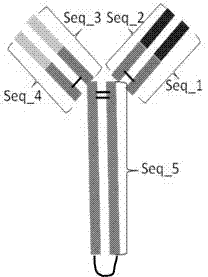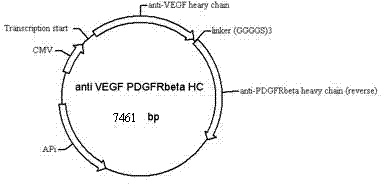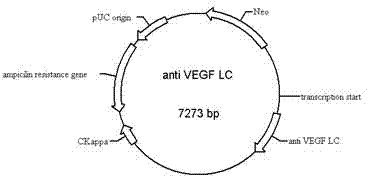Anti-VEGF/PDGFR (Vascular Endothelial Growth Factor/Platelet-Derived Growth Factor Receptor) beta double-specificity antibody and application thereof
A bispecific antibody and antibody technology, applied in the direction of antibodies, anti-tumor drugs, hybrid immunoglobulins, etc., can solve the problems of high toxicity and toxicity, achieve good tumor activity, inhibit growth, and avoid the increase of drug dosage Effect
- Summary
- Abstract
- Description
- Claims
- Application Information
AI Technical Summary
Problems solved by technology
Method used
Image
Examples
Embodiment 1
[0072] 1. Nucleotide sequence design and synthesis of anti-VEGF-PDGFRbeta bispecific antibody (bsAb):
[0073] Such as figure 1 Shown, according to the heavy chain HC of the bsAb VEGF -(GGGGS) 3 -HC PDGFRbeta (Reverse) amino acid sequence and connection form Design heavy chain nucleotide sequence, and add Sac I restriction site, KOZAK sequence and leader sequence at the 5' end of the sequence, and add Xho I restriction site at its 3' end point. Design three oligonucleotide primers containing EcoR I restriction site at the 3' end to synthesize heavy chain HC respectively VEGF -(GGGGS) 3 and HCPDGFRbeta (Reverse) fragment, the full-length 2658bp bsAb heavy chain gene was synthesized by PCR direct ligation method (SDL PCR).
[0074] According to the amino acid sequence of human anti-VEGF-A IgG1 light chain and human anti-PDGFRbeta IgG1 light chain amino acid sequence, the 5' end contains Not I restriction site, KOZAK sequence and leader sequence, and the 3' end contains Psi...
Embodiment 2
[0086] Antigen-antibody binding test (ELISA method):
[0087] 1. Coating: Dilute the antigen (hVEGF-A or PDGFRbeta) to a protein content of 5 μg / ml with 0.05M PH9.1 carbonate coating buffer. Add 0.1ml to the reaction well of each polystyrene plate, overnight at 4°C. The next day, the solution in the well was discarded, and washed 3 times with washing buffer, 3 minutes each time.
[0088] 2. Adding samples: Add 0.1ml of a certain dilution of the antibody to be tested (anti-VEGF Fab, anti-PDGFR beta monoclonal antibody or anti-VEGF-PDGFR beta bsAb) to the above-mentioned coated reaction wells, and incubate at 37°C for 1 Hour. Then wash. (Make blank wells, negative control wells and positive control wells at the same time).
[0089] 3. Add enzyme-labeled antibody (goat anti-human IgG-gamma): Add 0.1 ml of freshly diluted enzyme-labeled antibody (diluted after titration) to each reaction well. Incubate at 37°C for 0.5-1 hour and wash.
[0090] 4. Add substrate solution for c...
Embodiment 3
[0097] Anti-VEGF / PDGFRbeta bispecific anti-human nasopharyngeal carcinoma CNE xenograft tumor growth inhibition test in nude mice
[0098] Take the tumor tissue in the vigorous growth period and cut it into 1.5mm 3 Left and right, under sterile conditions, inoculated subcutaneously on the right side of nude mice. Use a vernier caliper to measure the diameter of the transplanted tumor in mice, and wait until the tumor grows to 100-200mm 3 Animals were then randomly grouped. Using the method of measuring the tumor diameter, dynamically observe the anti-tumor effect of the tested animals. Tumor diameter was measured once every 2 days, and the weight of the mouse was also weighed at the same time as each measurement. The experimental group was injected with anti-VEGF / PDGFRbeta bispecific antibody through the tail vein, once a day, and the negative group was given the same amount of normal saline at the same time. Tumor volume calculation formula:
[0099] TV=0.52×a×b 2
[0...
PUM
| Property | Measurement | Unit |
|---|---|---|
| Tumor inhibition rate | aaaaa | aaaaa |
| Tumor inhibition rate | aaaaa | aaaaa |
| Tumor inhibition rate | aaaaa | aaaaa |
Abstract
Description
Claims
Application Information
 Login to View More
Login to View More - R&D
- Intellectual Property
- Life Sciences
- Materials
- Tech Scout
- Unparalleled Data Quality
- Higher Quality Content
- 60% Fewer Hallucinations
Browse by: Latest US Patents, China's latest patents, Technical Efficacy Thesaurus, Application Domain, Technology Topic, Popular Technical Reports.
© 2025 PatSnap. All rights reserved.Legal|Privacy policy|Modern Slavery Act Transparency Statement|Sitemap|About US| Contact US: help@patsnap.com



